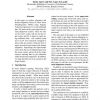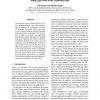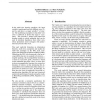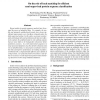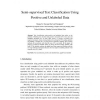COLING
2008
14 years 27 days ago
2008
In this paper we explore robustness and domain adaptation issues for Word Sense Disambiguation (WSD) using Singular Value Decomposition (SVD) and unlabeled data. We focus on the s...
AAAI
2010
14 years 27 days ago
2010
In this paper, we study cost-sensitive semi-supervised learning where many of the training examples are unlabeled and different misclassification errors are associated with unequa...
ACL
2008
14 years 27 days ago
2008
This paper provides evidence that the use of more unlabeled data in semi-supervised learning can improve the performance of Natural Language Processing (NLP) tasks, such as part-o...
COLT
2008
Springer
14 years 1 months ago
2008
Springer
We study the potential benefits to classification prediction that arise from having access to unlabeled samples. We compare learning in the semi-supervised model to the standard, ...
COLT
2008
Springer
14 years 1 months ago
2008
Springer
In the multi-view learning paradigm, the input variable is partitioned into two different views X1 and X2 and there is a target variable Y of interest. The underlying assumption i...
BIBM
2008
IEEE
14 years 1 months ago
2008
IEEE
Recent studies in protein sequence analysis have leveraged the power of unlabeled data. For example, the profile and mismatch neighborhood kernels have shown significant improveme...
DASFAA
2004
IEEE
14 years 3 months ago
2004
IEEE
Text classification using a small labeled set and a large unlabeled data is seen as a promising technique to reduce the labor-intensive and time consuming effort of labeling traini...
AMT
2006
Springer
14 years 3 months ago
2006
Springer
Text classification using positive and unlabeled data refers to the problem of building text classifier using positive documents (P) of one class and unlabeled documents (U) of man...
PERCOM
2010
ACM
14 years 3 months ago
2010
ACM
Abstract—In pervasive computing, localizing a user in wireless indoor environments is an important yet challenging task. Among the state-of-art localization methods, fingerprint...
ICDM
2003
IEEE
14 years 4 months ago
2003
IEEE
Semi-supervised learning methods construct classifiers using both labeled and unlabeled training data samples. While unlabeled data samples can help to improve the accuracy of trai...
